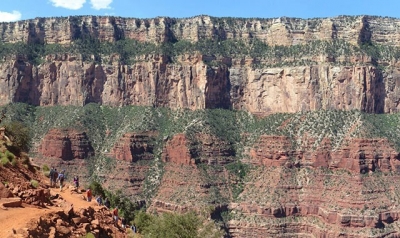
The geology of the Grand Canyon area includes one of the most complete and studied sequences of rock on Earth. The nearly 40 major sedimentary rock layers exposed in the Grand Canyon and in the Grand Canyon National Park area range in age from about 200 million to nearly 2 billion years old. Most were deposited in warm, shallow seas and near ancient, long-gone sea shores in western North America.
Rock layers formed during the Paleozoic Era are the most conspicuous in the Grand Canyon’s walls. Coastal environments and several marine incursions from the west between 550 and 250 million years ago deposited sandstone, shale and limestone layers totaling 2,400 to 5,000 feet thick.
Layers from the Cambrian, Devonian, Mississippian, Pennsylvanian and Permian periods are present. Erosion has removed most Mesozoic Era evidence from the Park, although small remnants can be found, particularly in the western Grand Canyon.
Nearby rock outcrops suggest 4,000 to 8,000 feet of sedimentary layers from the “Age of Dinosaurs” once covered the Grand Canyon area. Cenozoic Era (the “Age of Mammals”) layers are limited to the western Grand Canyon and terraces near the river itself. A few sedimentary deposits formed in lake beds, but the most spectacular recent deposits are the lava flows and cinder cones on the Shivwits and Uinkaret plateaus. Volcanic activity began about six million years ago and has continued to within the last several thousand years. Spectacular lava cascades down the Canyon walls have helped date the Grand Canyon’s carving.
Credit : National Park Service
Picture Credit : Google




